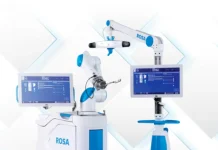Cala announced new results from multiple clinical studies further expanding the body of evidence for its TAPS therapy. TAPS (transcutaneous afferent patterned stimulation) therapy aims to treat essential tremor (ET). Cala offers the Cala kIQ non-invasive, FDA-cleared, wearable device for action hand tremor relief in those with ET and Parkinson’s. It treats tremor by sensing each patient’s unique tremor signature. It delivers individualized stimulation to the nerves on the wrist that reach the brain to counteract tremor. The company launched kIQ about a year ago.
Related: Anaconda Biomed enrolls first patient in study of funnel catheter for treating stroke
At the American Academy of Neurology (AAN) meeting in San Diego, multiple clinical study presentations exhibited data supporting TAPS. The studies showed that TAPS improves underlying tremor severity with consistent usage. It also supported the TAPS mechanism of action acts on the same brain network as deep brain stimulation (DBS). Finally, data showed reduced ET-related healthcare costs over a 12-month prospective study.
“We are thrilled that Cala is honored in Fast Company’s 2025 Most Innovative Medical Device Companies List impacting health and culture,” said Deanna Harshbarger, CEO, Cala Health. “Cala is committed to customer-centric innovation that transforms the standard of care for patients and clinicians. With the only FDA-cleared wearable neuromodulation system commercially available for tremor relief in ET and PD patients, Cala continues to raise the bar with advancements in technology and clinical evidence.”
One analysis looked at data from the multi-center PROSPECT study of 263 patients. It indicated that consistent usage of Cala TAPS reduces underlying tremor severity. Investigators measured this across eight daily activities, with more than 80% of participants improving after one and three months of TAPS at home.
Cala also reported that a study showed that TAPS modulated neural activity in the ventral intermediate (VIM) nucleus of the thalamus. The company called VIM a broadly adopted site for DBS to treat ET and a key area in tremor control. Eight patients receiving TAPS demonstrated a correlation between the degree of modulation in the VIM thalamus and tremor improvement. It suggests that TAPS reduces tremor by directly influencing neural activity in key tremor-related brain networks. The study also demonstrated significant tremor reduction in both the treated and untreated limbs, with greater improvement in the treated limb.
Finally, a 12-month prospective study demonstrated significant tremor relief and reduced ET-related healthcare costs in patients. Comparing 153 patients using TAPS for a 12-month period to an external control arm of 306 matched patients from a national payor database, TAPS delivered a reduction in ET-related costs, plus a marked improvement in tremor severity and daily functioning.
Cala says this highlights TAPS as a valuable treatment option for managing tremors and improving quality of life.
“We are excited to see Cala TAPS therapy not only provides acute relief for tremor patients but also improves underlying tremor severity with consistent use,” said Kate Rosenbluth, founder, president and chief innovation officer, Cala Health. “Cala continues to build clinical evidence to support TAPS outcomes improving the lives of ET patients and bringing value to healthcare, expanding our strong body of clinical evidence in over 2,000 patients, including randomized controlled trials, mechanism-of-action studies and real-world evidence analyses.”






